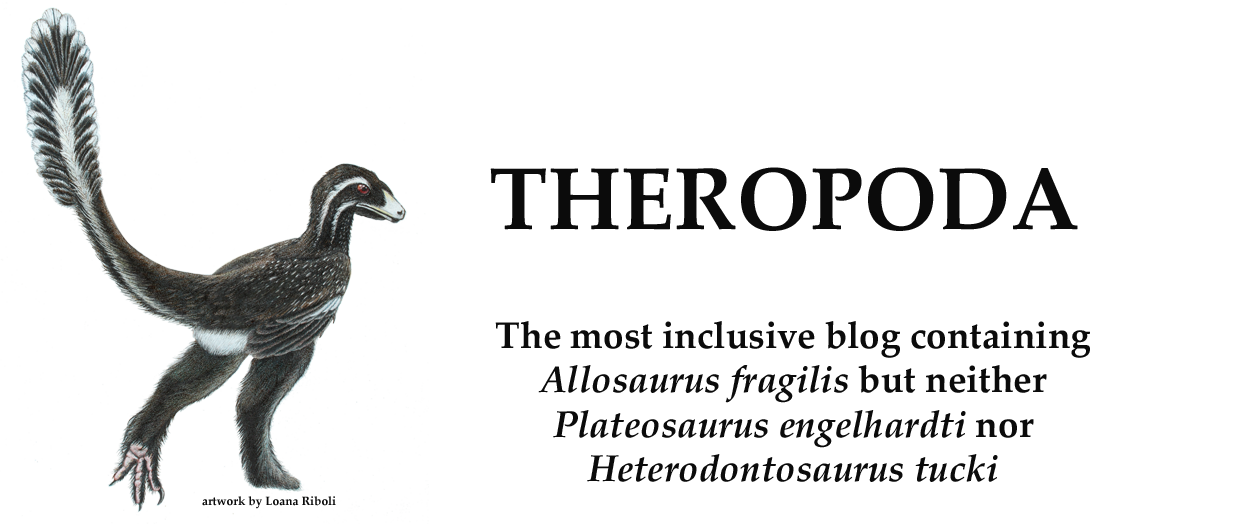Vi segnalo il numero di Ottobre 2014 del National Geographic, dedicato a Spinosaurus e ricco di fotografie del fossile, del mitico Stromer e dei protagonisti della ricerca. L'articolo è riccamente illustrato dal nostro Davide Bonadonna, quindi una vera chicca per appassionati di paleoarte (Davide, preparati ad autografare la mia copia!). Inoltre, e solamente per l'edizione italiana, è presente anche un articolo dedicato alla "parte italiana" di questa ricerca.


Corro in edicola!!!!
RispondiEliminaAttendevo la notizia. Volo!
RispondiEliminaMa la frase ''il più grande carnivoro vissuto sulla Terra'' non accenna a morire
RispondiEliminaSono andati ueri in edicola ma ancora non è arrivato, on vedo l'ora di averlo... sarebbe bello farlo autografare da Bonadonna, Maganuco e Dal Sasso, peccato che sono un "terrone" e stanno tutti al nord :)
RispondiEliminaRiccardo
*andato ieri.... maledetto touch
EliminaRiccardo
Sabato pomeriggio al Cappellini c'è una conferenza sul mosasauro della val Marecchia. Per caso ci sarà anche Davide? Così me lo faccio autografare anch'io...
RispondiEliminaAlessandro (Bologna)
No, ci saranno solamente quei due criminali di Fanti e Cau.
Eliminaperché il più grande carnivoro mai comparso sulla terra?
RispondiEliminaInteressanti anche i retroscena della scoperta.
RispondiEliminaSe le indicazioni fornite nei due articoli sono corrette, dovremmo ringraziare pubblicamente anche il geologo Flavio Bacchia di Trieste che, dopo aver acquistato i reperti in Marocco per una cifra abbastanza rilevante per un collezionista privato, ha poi deciso di donare al Museo di Milano questi fossili dal valore scientifico inestimabile.
Se ho ben capito, però, il materiale potrebbe rientrare in Marocco al Museo di Casablanca.
Si tratta di un accordo fra le due istituzioni museali o è prevista qualcosa del genere nella normativa sul rinvenimento dei fossili da parte del governo marocchino?
I nuovi resti saranno conservati al Museo di Casablanca, come risultato di un ampio lavoro di salvaguardia del materiale fossile marocchino. Il merito del "salvataggio" di questo fossile va a molte persone, ma i più importanti sono stati Nizar e Simone.
RispondiEliminaIl reperto conservato a Milano rimane in Italia?
EliminaLuca.
Sì.
EliminaI would like to clarify a few questions:
RispondiElimina1-In 2013 a study was conducted about the mandibular ability spinosaurids (using a Baryonyx and Spinosaurus), I would like to know your opinion on the results and if the authors of the National Geographic study took into account this study because I have not seen anyone doubt the conclusions
http://www.plosone.org/article/info%3Adoi%2F10.1371%2Fjournal.pone.0065295#close
2-You think the new 100% reliable reconstruction of the skeleton of Spinosaurus, I'm asking because I've seen this issue again and I think it is almost as high as the reconstruction of National Geographic: http://oi59.tinypic.com/ a1qq7a.jpg
http://www.nerdist.com/wp-content/uploads/2014/09/Spinosaur-3.jpg
Actually I guess there are no estimates accurate length of this issue and I would like to know if the animal was reammente as low as shown by the new reconstructions.
1- That's a paper on spinosaurid snout mechanical properties compared to different crocodyliform morphotypes. I'm not in the brain of any of the authors, so don't know if the took something into account.
Elimina2- Spinosaurus was that low, due to the very short limbs.
The authors of the new expo say their reconstruction is not 100% accurate, then the proportions of exposed skeleton are not correct at all?
EliminaYour question is misleading.
EliminaALL skeletal reconstructions are not "100% accurate" as it is impossible to reconstruct in a perfect way an extinct animal known from fragmentary elements: that is what "reconstruction" means. At the same time, this does not mean that an exposed skeleton is "not correct at all" (that would mean "0% accurate").
Well I asked something similar to Thomas Holtz, he told me that the new reconstruction needs a few changes as some parts of the animal were reconstructed to "imagination" of authors, especially the arms. In addition to that the length of the new sample is unknown to assume the proportions of the hind legs.
EliminaWhat I'm getting at is that it really Spinosaurus legs were so short as shown in reconstruction
https://scontent-a-mia.xx.fbcdn.net/hphotos-xaf1/v/t1.0-9/1920471_882368265109273_5427027745364792281_n.jpg?oh=77b6d0e6d75d94224fb684c882475478&oe=54C43160
The reconstruction is what every reconstruction is: an hypothesis based on what is actually known based on a series of assumptions. No more no less. The authors are aware of this.
EliminaI know, all reconstructions are based on existing data, you cannot reconstruct an animal at 100%
EliminaIeri ho acquisto l'edizione in spagnuolo per América è sono gli stessi articoli .Una lettura interessante, ma un pò leggera, con belle ricostruzioni.
RispondiElimina